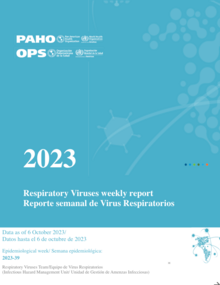North America: Influenza activity has remained at low levels. During the last four epidemiological weeks (EWs), the predominant influenza viruses have been influenza A(H1N1)pdm09, with concurrent circulation of influenza B/Victoria and to a lesser extent, influenza A(H3N2). Respiratory syncytial virus (RSV) activity has remained low. SARS-CoV-2 activity continues to rise at moderate levels. Cases of influenza-like illness (ILI) and severe acute respiratory infection (SARI), which had shown an increase associated with positive cases of SARS-CoV-2, have decreased in the last two EWs. In Mexico, influenza circulation in the last four EWs has remained at epidemic levels, and SARI activity is at moderate levels, with the majority of cases associated with SARS-CoV-2 and to a lesser extent with influenza.
Caribbean: Influenza activity continues to show a decreasing trend in the last four EWs. During this period, the predominant viruses have been influenza B/Victoria, with lesser circulation of influenza A, mainly A(H1N1)pdm09, followed by influenza A(H3N2). RSV activity has remained low, showing a slight increase. SARS-CoV-2 activity has remained at intermediate levels, with a decreasing trend in the last four EWs. Cases of ILI and SARI have shown a decreasing trend in the last four EWs. Barbados, Guyana, Jamaica, and Saint Lucia have maintained high levels of SARS-CoV-2 circulation.
Central America: Influenza activity remains at low levels of circulation. During this period, the predominant influenza viruses have been influenza B/Victoria, with concurrent circulation of influenza A, mainly A(H1N1)pdm09, followed by influenza A(H3N2) to a lesser extent. RSV activity has remained elevated in the last four EWs. SARS-CoV-2 activity is at low levels with a decreasing trend. The number of new cases detected for ILI and SARI has remained low; however, the proportion of SARI cases attributable to RSV remains high. In El Salvador, RSV activity continues to be high, while SARS-CoV-2 activity has declined in the last 2 EWs, and influenza activity has shown a slight increase. In Guatemala, in the last four EWs, RSV activity remains high, with most SARI cases being positive for RSV. In Honduras, influenza and SARS-CoV-2 activity have decreased in the last four EWs. In Nicaragua, influenza activity remains on the decline at epidemic levels. In Panama, influenza activity is currently below the epidemic threshold, and RSV activity remains at moderate levels.
Andean Region: Influenza activity remains stable at low levels of circulation. During the last four EWs, the predominant influenza viruses have been influenza B/Victoria, followed by influenza A, mainly A(H1N1)pdm09. RSV activity remains low but has shown a slight increase in the last two EWs. SARS-CoV-2 remains at moderate levels of activity, with particularly high circulation in Bolivia, a pronounced increase in Ecuador to high levels, and a slight increase in Peru. SARI and ILI activity remains at low levels.
Brazil and Southern Cone: Influenza activity remains at low levels of circulation. During the last four EWs, the predominant influenza viruses have been mainly influenza B/Victoria, with simultaneous circulation of influenza A(H1N1)pdm09. RSV activity remains low. SARS-CoV-2 activity remains at intermediate levels of circulation. Both SARI and ILI activity have remained low in the last four EWs. Argentina has shown moderate SARS-CoV-2 activity, although ILI and SARI levels are below the epidemic threshold. In Brazil, SARS-CoV-2 activity continues to rise. In Chile, there has also been a pronounced increase in SARS-CoV-2 activity with high levels of circulation and moderate ILI levels. In Paraguay, SARS-CoV-2 circulation has decreased, and SARI activity is declining. In Uruguay, SARI activity is declining in the last four EWs, with most cases associated with RSV, which has shown a decrease in circulation in the last four EWs, and to a lesser extent with SARS-CoV-2, which remains at low activity levels.
|

